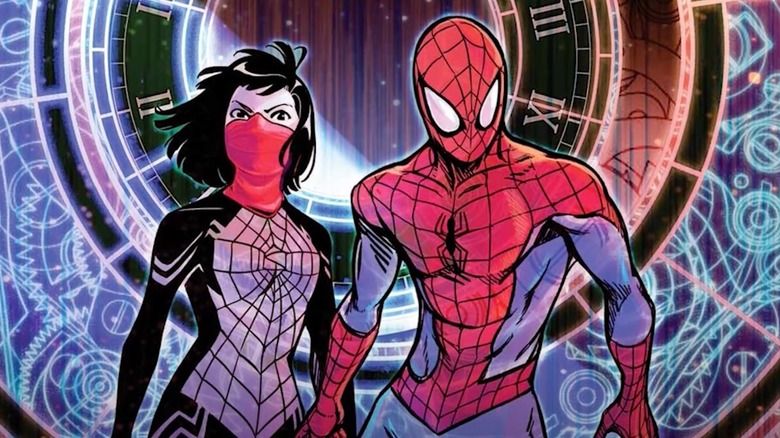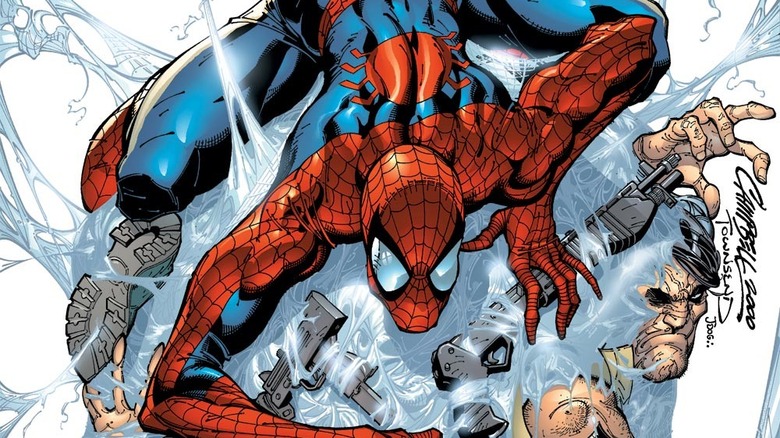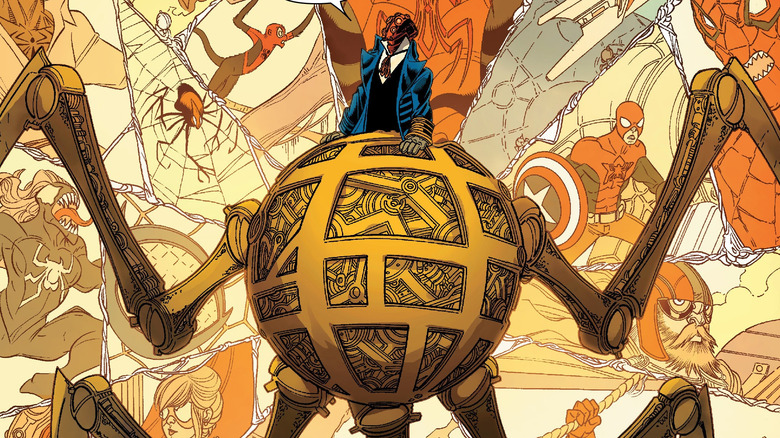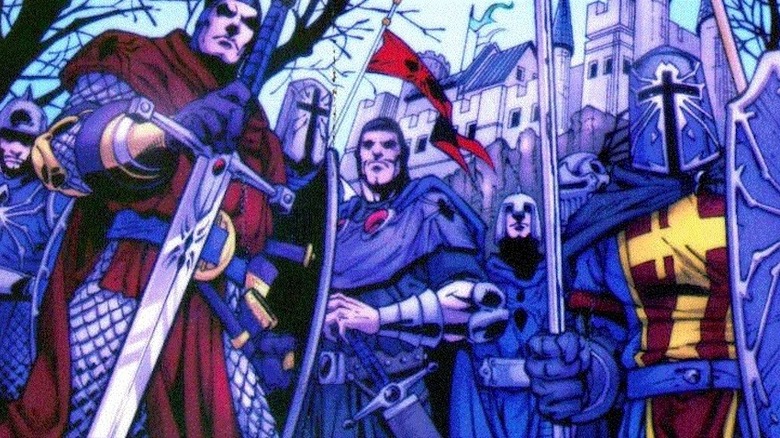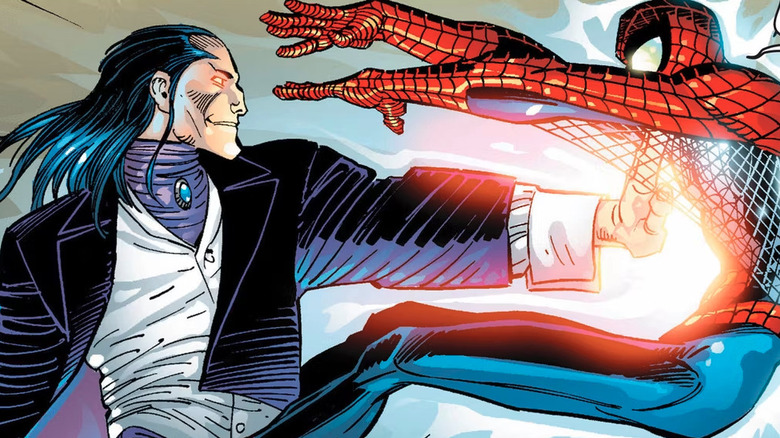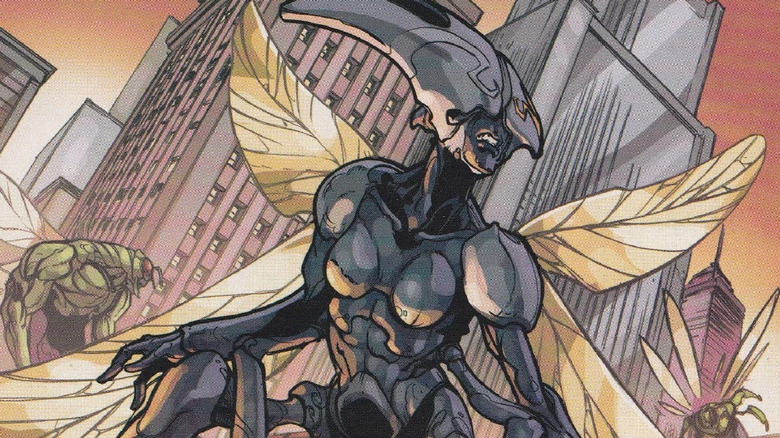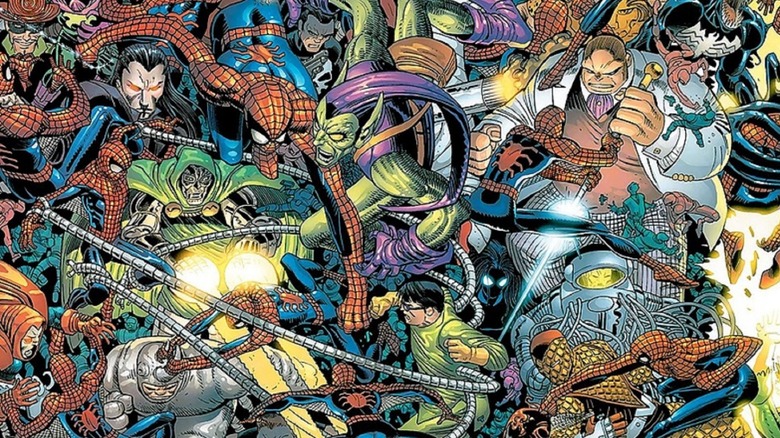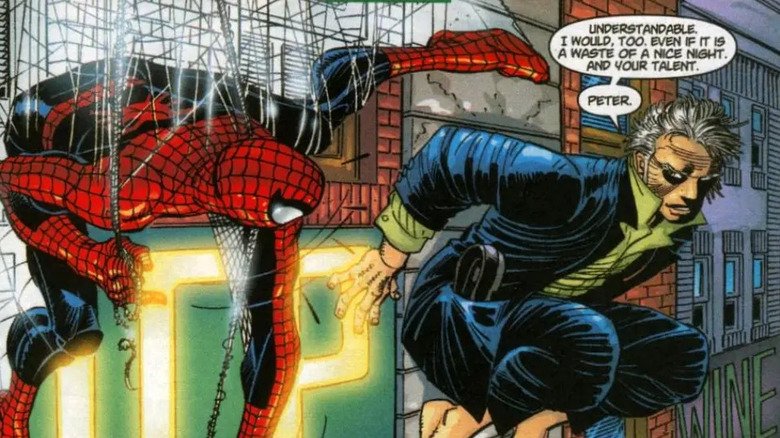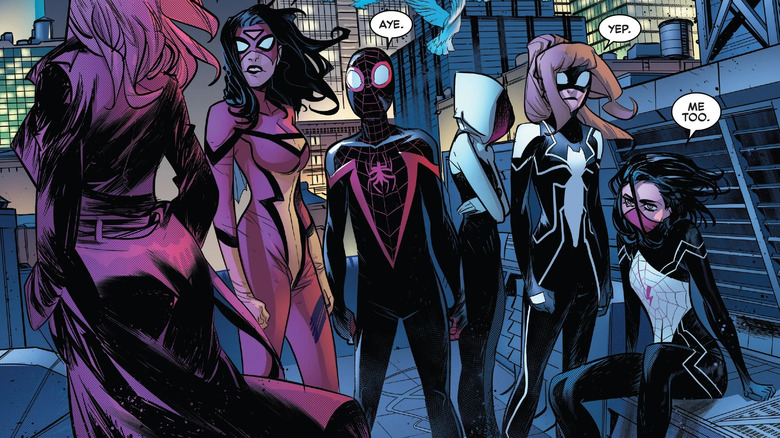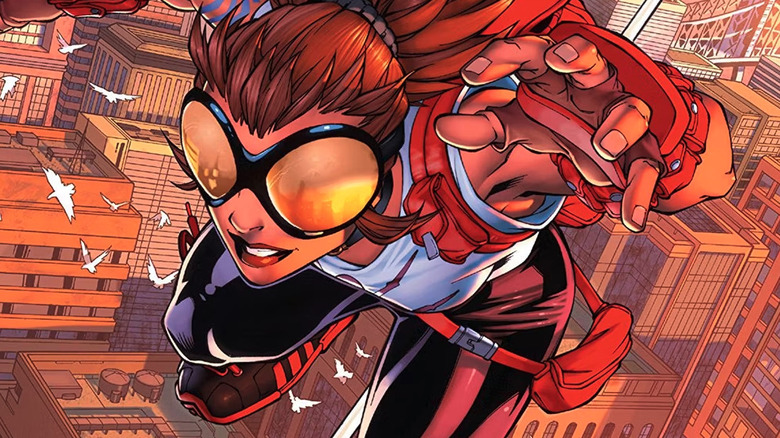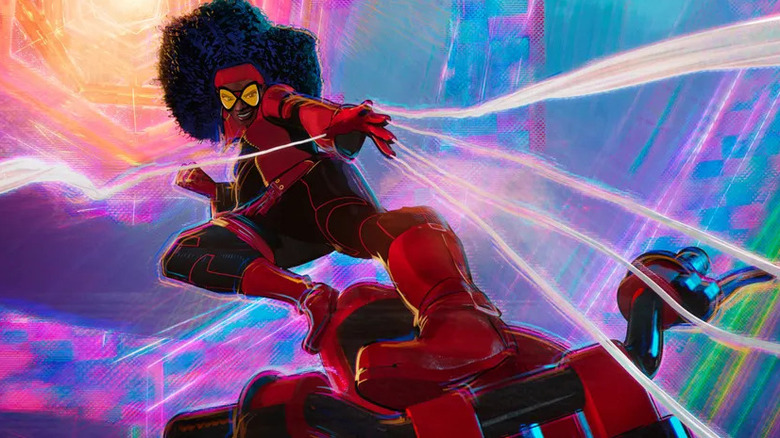The Untold Truth Of Marvel's Spider-Society
From Peter Parker to Miles Morales, few characters have delighted fans around the globe as much as the iconic wallcrawler Spider-Man, Marvel's flagship hero for more than six decades. But little did we know that Spidey's web-slinging legacy runs deep into the multiverse, and over the years we've met countless alternate versions of the webhead that go back hundreds of years. This has led to the discovery of a clandestine group known as the Spider Society, who worship the powers of the spider.
Introduced on film in the groundbreaking animated sequel "Spider-Man: Across the Spider-Verse," the Spider Society has a rich history within the comics that has affected a number of pivotal events in the Marvel universe. Dating back centuries, the Spider Society's origins are steeped in mysticism and shrouded in secrecy. Its members have been chosen to protect the delicate balance between realms and keep the peace on various worlds, while their unique abilities allow them to defend against all manner of threats that lurk in the shadows between dimensions. Though the Spider Society has kept themselves mostly hidden, their existence spins a complex web that connects a number of heroes and villains alike.
Whether you've read all of their adventures already, or have never heard of the Spider Society, you may want a primer on this elusive team of spider-powered legends. So grab your webshooters, because we're taking a trip into the history and lore of these ancient guardians — the untold truth of the Spider Society.
The Spider Society debuted in an iconic issue
In the grand scheme of Spider-Man's long and winding history, Marvel's Spider Society is a relatively recent addition, debuting in the pages of "The Amazing Spider-Man" in spring 2001. Their first appearance, in fact, came in a now-iconic issue that set Peter Parker on an Earth-shattering journey that would reshape the hero's identity forever. It was issue #30 of the recently relaunched title, and it saw a new creative team come aboard the book, with legendary artist John Romita Jr. taking the reins of the series. The title also boasted a new look and feel that included reverting the series logo to its classic design, back from the more flashy, '90s revamp seen previously.
In the issue, fans were introduced to a pair of new characters: the mysterious Ezekiel, a wise old man who seems to have the exact same powers as Spider-Man, and the even more enigmatic vampire called Morlun, who arrives with nefarious motives. Little did fans know at the time, but this new duo would become an integral part of the hero's story over the next decade, and expand Spider-Man's mythology in ways nobody could have predicted.
We'd later learn, of course, that Ezekiel is a member of the Spider Society, who worship beings created by the goddess Neith known as Spider-Totems, and grant spider-powers to their members. Morlun, meanwhile, is eventually exposed as part of a group of deadly manhunters called the Inheritors.
The Spider Society is connected to the multiverse
Beyond the Spider-Totems worshiped by the Spider Society, the elder goddess Neith also created a vast cosmic network known as the Web of Life and Destiny. This five-dimensional nexus serves as a portal between multiple parallel realities, a gateway that allows those who control it to access the entirety of the multiverse. It is this Web of Life and Destiny that is also responsible for providing powers to the likes of Spider-Man, Spider-Woman, and even Madame Web.
This nexus of realities is overseen by the Master Weaver, who must spin the web and maintain its construct. The previous Master Weaver, however, was a powerful entity who once belonged to the Inheritors and also sought to destroy all Spider-heroes across all of reality. The Master Weaver is killed during the climactic "Spider-Verse" crossover event, and in the aftermath a being known as Karn takes over the role. Karn becomes allies with the Spider Society and various heroes, including Peter Parker, Jessica Drew, and Miles Morales, who are all Spider-Totems themselves.
Later, it is revealed that Karn's predecessor was actually a future version of himself, meaning that he may be destined to become a dangerous villain. Nevertheless, Karn and his spider-powered allies are now tasked with watching over and protecting the Web of Life and Destiny, and ensuring the safety of Spider-Men across the multiverse from attacks by their enemies.
The Spider Society has existed for hundreds of years
The Spider Society is more than just a collection of heroes with spider-powers. They're actually an ancient, secretive organization not unlike the Illuminati or Freemasons, with origins that can be traced back almost a thousand years. In their case, they were founded around the 11th century in Castile, France, where they gathered for the first time as a quasi-religious order to worship the deities known as Spider-Totems. Their purpose was to serve as clandestine guardians and protectors, and they fought for peace at the height of the Crusades.
The structure of the Spider Society was built around the bonding of the Mage and the Hunter, whose powers are amplified when together. The Hunters were born possessing incredible powers which were passed down through generations, powers that you'd recognize from the hero Spider-Man. In the modern day, the Spider Society has survived thanks to Ezekiel Sims, who founded WebCorps, a multinational shell corporation that has funded the Spider Society's activities into the 21st century.
The Hunters meanwhile, were Spider-Totems who served the Spider Society in the group's various conflicts as its direct combatants. Other Spider-Totems, over the centuries, included the likes of Kwaku Anansi, the very first Spider-Man and an extra-dimensional being who the Africans worshiped as a spider god. In fact, most of the spider-powered heroes in the Marvel universe are Spider-Totems themselves, all chosen and given their powers by the Spider Society, whether they realized it or not.
A family of vampires seeks to destroy the Spider Society
The vampire known as Morlun was an addition to Spider-Man's rogues gallery in the early 2000s. An immortal bloodsucker, he led a family of the unliving known as the Inheritors, who were on a centuries-old quest to vanquish the Spider-Totems. But they didn't just want to kill the ones on their own world; Originating from Earth-001, Morlun and the Inheritors wanted to destroy all Spider-Totems in all conceivable realities, and set out to kill as many Spider-heroes as they could through the vast multiverse.
The Inheritors were able to embark on this quest after Morlun sought out and battled the Master Weaver and gained control over the Web of Life and Destiny. One of Morlun's targets was Ezekiel Sims, who he hunted down across realities until he arrived on Earth-616, in Marvel's prime universe. When Ezekiel was able to find a means of defense against Morlun and his Inheritors, he used his knowledge to also protect other Spider-Totems — including Peter Parker, who he sought out and to whom he revealed the secrets of the Spider Society. It was Ezekiel's new connection to Peter Parker, however, that put the wallcrawler on Morlun's radar.
In response to the Inheritors' attacks, a Spider-Man from Earth-833 assembled a group of fellow heroes from across the multiverse, forming what became known as the Spider-Army. Earth-616 Spider-Man would become their leader for a time, recruited since he already defeated Morlun more than once.
The Spider Society has waged a centuries-long war with the Sisterhood of the Wasp
Morlun and his Inheritors aren't the only enemies that the Spider Society have faced. They have also been locked in a war with another brotherhood — or should we say sisterhood — for hundreds of years. They're called the Sisterhood of the Wasp, and they were born out of the Spider Society itself. A group of warriors who rejected the Spider Society's less violent plans to balance the scales of power, they came into conflict with their leaders over how best to achieve a better world.
In the eyes of these warriors, it would take not just extraordinarily lethal methods to achieve their goals, but world domination as well. At odds with the rest of the Spider Society, they splintered off to become the Sisterhood of the Wasp, led by the powerful All-Mother. Since then, they have had no qualms about killing and have battled the Spider Society in their own quest to reshape the world as they see fit, which now includes destroying the Spider Society.
The Sisterhood of the Wasp is structurally just like the Spider Society, with a Mage and Hunter, and the two groups have often fought over their recruits. The Sisterhood of the Wasp has also been involved in a number of major storylines, including "Spider-Island," which saw New York's population infected with a virus that turned them into spider monsters. Eventually, the Sisterhood switched sides, albeit momentarily, to help cure the virus.
The Spider Society retconned Peter Parker's origin as Spider-Man
For nearly 40 years, Peter Parker's origin as Spider-Man was one of the most famous in all of comics: he was bitten by a radioactive spider as a teenager and bestowed with the incredible abilities of the arachnid, allowing him to walk on walls and sense danger before it happened, while gaining phenomenal strength, agility, and superhuman durability. Plus, thanks to his own ingenuity, Parker was also able to spin webs that made him even more spider-like. But the introduction of the Spider Society completely turned that origin on its head, in what became one of the biggest retcons in the character's history to that point.
As revealed in the "Coming Home" story arc, we learn from Ezekiel that Peter Parker wasn't given his powers in a random accident. Instead, he was anointed a Spider-Totem due to his troubled upbringing, which saw him bullied, yet unwilling to use violence to fight back. The Spider Society deemed him worthy of their ranks, and Ezekiel revealed that his selection to become a future Hunter for them led to his powers being granted to him by the bite of the radioactive spider.
Though how they may have orchestrated those events is left ambiguous — and it's left up to the reader to interpret — the clear message is that Peter Parker's powers are part of a grand plan by mystical forces that go far beyond a single lab accident involving an irradiated arachnid.
Spider Society hunter Ezekiel has mentored multiple Spider-heroes
Ezekiel Sims was readers' first introduction to the Spider Society, and his intentions early on were anything but clear. A mysterious figure who seemed at times like a villain, there was good reason for Peter Parker to be suspicious of him. It was eventually revealed that Sims was using Spider-Man in a plot to avert his own death in a ritual sacrifice, all in the hopes of keeping his powers and saving his own life. But Sims wasn't quite the diabolical foe that you'd expect from a man with such a sinister plan, and he wound up mentoring more than one hero during his adventures.
This of course included Parker himself, who he helped guide after informing him about his destiny as a Spider-Totem. Beyond Parker, Sims was also responsible for raising another member of Marvel's Spider-family, the hero now known as Silk. Born Cindy Moon, she was bitten by the same spider that bit Peter Parker, giving her the same extraordinary abilities. Unable to control her powers as a young child, she was whisked away by Sims, who did more than just raise her, but taught her how to use her abilities.
When Ezekiel discovered that Moon's emergence had drawn the attention of Morlun, he decided to keep her safe by locking her in a bunker filled with years' worth of supplies. When she was finally released by Spider-Man, she took the identity of Silk, and became a hero in her own right.
Peter Parker isn't the only Spider-Man to be a member of the Spider Society
Spider-Man and Silk aren't the only heroes in the Marvel Universe to be connected to the Spider Society, as many members of his corner of the comics are actually Spider-Totems. This includes Jessica Drew, also known as the original Spider-Woman, who actually served as a Hunter for the Spider Society for a time. Both Spider-Man and his clones Ben Reilly and Kaine are also Spider-Totems, but it goes far beyond just Spider-heroes on Marvel's Earth prime, because a number of variant Spider-Mans from other realities have fought alongside the Spider Society, thanks to the Web of Life and Destiny that connects the multiverse.
The many Spider-Totems from across the multiverse include Spider-UK — Billy Braddock — of Earth-933, who founded the offshoot group known as the Web Warriors. There's also Spider-Ham, the animal hero from Earth-8311, Miles Morales from the Ultimate Universe, and Spider-Gwen of Earth-64. They and many others have all joined forces to fight with the Spider Society in a number of battles during a number of key storylines. They teamed up with a variety of other Spider-heroes in the massive "Spider-Verse" crossover where they fought and defeated the Inheritors, and in that story's follow-up, "Spider-Geddon," they fought back when the Inheritors resurfaced looking for revenge.
The Spider Society created Marvel's first Hispanic Spider-Girl
One of the most important Spider-heroes in the Marvel Universe with ties to the Spider Society is Aña Corazón.These days, she slings webs and fights crime under the name Spider-Girl, but may be better known to some as the hero Araña. She also happens to be the first Latina Spider-Girl, originally introduced in 2004, and her spider-powers weren't the result of a bite from an irradiated bug, but a gift from Miguel, the sorcerer of the Spider Society.
A teenage gymnast, Aña stumbled across Miguel while he was under attack from the Sisterhood of the Wasp, and was struck down while trying to help him. After the encounter, Miguel recognized in Aña the special heroic and selfless nature required to be a member of the Spider Society, and gave some of his powers to her to save her life. Miguel and the Spider Society believed that Aña could become their next Hunter, and in addition to joining their ranks, she later went to work for WebCorp, the company that served as a front for the organization.
Later, however, Aña decided to leave WebCorp and the Spider Society, taking the name Araña and deciding to strike out on her own as an independent hero. Jessica Drew took Araña under her wing, and re-dubbed her Spider-Girl.
The Spider Society was created by a sci-fi icon
The Spider Society signaled their introduction in the "Coming Home" storyline that began in volume 2, issue #30 of "The Amazing Spider-Man" in 2001. It was a major overhaul of the comic, as previously mentioned, with a new creative team, a new look, and a bold new direction.
The man behind it all was writer J. Michael Straczynski, best known for his time as a producer and writer for television. A longtime sci-fi author, Staczynski is the man behind the '90s cult classic series "Babylon 5," which aired for five seasons, and is returning soon with an animated movie sequel. Straczynski is also the man behind the cult TV series "Jeremiah," which received an all-too-short two-season run in 2002, and helped Marvel craft its 2011 film "Thor." In 2013, he worked on the story for the big screen adaptation of "World War Z" starring Brad Pitt, then joined forces with the Wachowskis to create the Netflix original sci-fi drama "Sense8," writing 24 episodes.
A two-time Hugo Award-winner, he's as big a name as there is in science fiction, and his contributions to the "Spider-Man" mythos are immeasurable. The "Coming Home" story kicked off a long and successful run for him on the title, and he later branched out to write important runs on "Fantastic Four," "Thor," "The Incredible Hulk," and the "Ultimate" comics.
Their appearance in Across the Spider-Verse is very different from the comics
The Spider Society has finally made it to the screen after more than 20 years, showing up in the animated sequel, "Spider-Man: Across the Spider-Verse." This version of the group, though, is somewhat different than their comic book counterparts, and actually have much more in common with the Spider Army or the Web Warriors. In the film, they're a collection of various Spider-Man variants from across the multiverse, and while their leader is named Miguel, it's a very different one. This time, it's Miguel O'Hara, also known as Spider-Man 2099 (voiced by Oscar Isaac).
Also unlike the Spider Society from the comics, this version of the team aren't strictly heroes, as they come into conflict with Miles Morales over how to stop a deadly new adversary called The Spot. "There's an antagonistic relationship between Miles and the Spider Society," director Joaquim Dos Santos told Den of Geek. "As you get older, you realize where the disconnect is between an idea and the enforcement of an idea. The Spider Society is riding a fine line."
This isn't going to be the last appearance for the team of Spider-People: not only is "Spider-Man: Beyond the Spider-Verse" due out in 2024, but it was announced that Amazon and Sony are teaming up on a streaming series centered on the Spider Society. "Silk: Spider Society" will air on MGM+ as part of Amazon Prime, from former "Walking Dead" executive producer Angela Kang.
